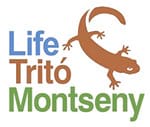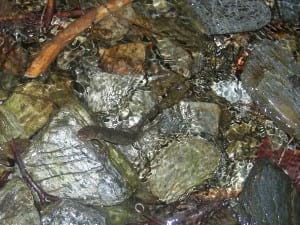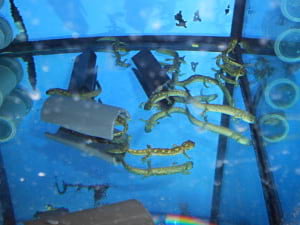Slider 1
Life Tritó Montseny
Un símbol de la natura del Montseny
Subbanner
LIFE15 NAT/ES/000757
Project of conservation of an only species to the world
Breadcrumb
Concrete conservation actions
Progress of Actions C:
C. Concrete conservation actions
C.1. Environmental planning and legislation: Conservation plan for the Montseny newt
Operational objective 4. To elaborate the Conservation and Management Plan for the Montseny newt and to establish the correct legal coverage at state and European level.
The aim of this action is to draw up the Montseny newt recovery plan in accordance with the guidelines established by state and community regulations for endangered species.
Photo: XPN Archive
C.2. Environmental planning and legislation: steps to include the Montseny newt in the Habitats Directive
Operational objective 4. To draw up the Conservation and Management Plan for the Montseny newt and to establish the correct legal coverage at state and European level
The purpose of this action is to amend Annex II to Council Directive 92/43/EEC of 21 May 1992 on the conservation of natural habitats and of wild fauna and flora to include the species Calotriton arnoldi, taxonomically separated from the original Euproctus asper, listed in Annex IV to that Directive. The aim of this action is to achieve a sound legal framework at European level that will enable the development of effective policies for the conservation of the species and environmental management.
The Generalitat de Catalunya has contacted the Ministry of Agriculture Habitats to include, as soon as possible, the species Calotriton arnoldi as a species of community interest. For conservation it is necessary to designate special areas of conservation (Annex II). We have received a positive response from the Ministry in which they are committed to promoting the inclusion of Calotriton arnoldi in the reference list of the report of Article 17 of the Habitats Directive. This sexennial report provides information on the conservation status of the Directive's species. In the last report, which covered the period 2007-2012, Calotriton arnoldi was evaluated within the section of the Mediterranean biogeographical region within the Euproctus asper profile.
The reference lists for the next report, which will cover the period 2013-2018, are still under review and since the MAGRAMA can request the inclusion of Calotriton arnoldi, so that an own evaluation of its state of conservation can be carried out, which will be made public in 2019.
Photo: Fèlix Amat.
C.3. Environmental planning and legislation: biodiveristy information system and database
Operational objective 5. Periodically know the state of conservation of the Montseny newt and expand scientific and technical knowledge for its conservation and management
The aim of the action is to incorporate into the information system and database of the GNP-RB Montseny (SIMSY) the reports prepared and the scientific and technical data acquired in the project. This action also aims to create a computer application for the exploitation of the data and Life results, for informative, technical and scientific purposes, for a dynamic geographical visualization. The information of an informative nature incorporated into SIMSY will be transferred to administrations and institutions linked to the conservation of natural spaces and biodiversity.
Photo: Fèlix Amat.
C.4. Remodelling of the water collection and distribution system
Operational objective 2. Increase the hydrological quality of streams and their ecological flow in the Montseny newt range
The aim of the action is to update surface water catchment systems, at the municipal level, in isolated houses and isolated farms, to ensure a minimum ecological flow during the driest months.
Photo: Daniel Guinart.
C.5. Promoting the sustainable and responsible use of water: installation of rainwater and greywater collection systems
Operational objective 2. Increase the hydrological quality of streams and their ecological flow in the Montseny newt range
The aim is to increase the capacity of accumulation of non-flood waters. The final objective is to reduce the amount of water extracted from the streams to provide the isolated houses and small inhabited core of the geographical area of the Montseny newt. This action is designed to complement the previous action of remodeling the catchments to reduce the amount of water extracted from the streams by providing extra water to the farmhouses and isolated agro-livestock farms, coming from the rain and the use of grey water.
Photo: XPN Archive.
C.6. Promoting the sustainable and responsible use of water: implementing green wastewater filters in isolated houses
Operational objective 2. Increase the hydrological quality of streams and their ecological flow in the Montseny newt range
The aim is to improve the quality of streams waters and prevent the discharge of wastewater that could harm the environmental conditions of the riverine environments. For this, it is necessary to implement water purification systems in the isolated farmhouses or small houses, where tertiary treatment and lagoons, called green filters, can significantly improve quality levels, reducing phosphates and nitrates to a minimum that are not harmful to biodiversity adapted to oligotrophic waters. These systems are based on the creation of artificial lagoons, where the vegetation absorbs the nutrients that concentrate the wastewater, so that the water that comes out of these lagoons has physicochemical conditions more similar to the conditions of the water that flows through the streams.
Photo: XPN Archive.
C.7. Improve riberbank habitat: ecological connectivity in streams through road infrastructures
Operational objective 3. Eliminate or minimize threats to the riverbank habitat currently occupied by the Montseny newt
The purpose of this action is to ensure the ecological connectivity of the riverbed along the entire stream where there is a population of Montseny newt. The interventions carried out within the framework of this action are intended to maintain the existing road communication and its road safety measures, but eliminating the barrier effect produced by many existing infrastructures, at the intersection of the road or forest track with the riverbed. In general, the interventions will consist of replacing the existing drainage pipes with bridges or square prefabricated structures to provide a natural continuity to the streams and watercourses. The earth moving and dismantling of the current road infrastructures will be used to restore the bed of the streams on both sides of the road or track, since in many cases it is totally collapsed by the rejection material of the old construction, which increases the barrier effect for the aquatic fauna of the streams.
Photo: Fèlix Amat.
C.8. Improve riparian habitat: native riparian habitats and good forestry practices
Operational objective 3. Eliminate or minimize threats to the riverbank habitat currently occupied by the Montseny newt
The aim is to restore the riverside habitat in the streams with the presence of the Montseny newt, recovering its native tree vegetation and its original cover, as well as avoiding erosion and sediment contributions to the streams of old forestry activities. The medium-term outcome of these interventions will restore the environmental and ecological conditions of the riverine habitat of the past, favouring populations of the Montseny newt and biodiversity associated with the riverine habitat. This action also has a strong demonstrative purpose, in terms of good forestry practices aimed at conservation.
Photo: Lluís Martínez.
C.9. Captive breeding and restocking of the Montseny newt: extension of the Torreferrussa breeding center
Operational objective 1. Ensuring genetic conservation and expanding the geographical distribution of the Montseny newt
The aim is to increase the facilities of the Torreferrussa breeding centre in order to achieve the necessary capacity for the maintenance of the genetic reserve and to obtain sufficient specimens for the reinforcement of natural populations.
At present, the Torreferrussa Wildlife Centre has a wooden hut of about 30m2 where the captive breeding pilot program has been carried out since its inception in 2007. These facilities do not have the capacity to house the total number of specimens required by the ex-situ conservation program.
It is intended to build new facilities with sufficient capacity to house a separate breeding nucleus for each of the populations of the species existing in the natural environment. The new facilities will be used for the maintenance of the breeding specimens and those belonging to the genetic reserve. The existing facilities will be used for the growth of larvae intended to strengthen wild populations.
Photo: Francesc Carbonell.
C.10. Captive breeding and restocking of the Montseny newt: operation of the Torreferrussa breeding center
Operational objective 1. Ensuring genetic conservation and expanding the geographical distribution of the Montseny newt
The aim is to maintain the captive breeding programme for the Montseny newt, carried out at the Torreferrussa breeding centre.
Photo: Fèlix Amat.
C.11. Captive breeding and restocking of the Montseny newt: expand and improve the breeding center of the Barcelona Zoo
Operational objective 1. Ensuring genetic conservation and expanding the geographical distribution of the Montseny newt
The aim of this action is to expand the current breeding and maintenance aquariums of the Montseny newt to double the production of specimens from the eastern populations. In the Barcelona Zoo, there is currently a breeding area for the Montseny newt with 3 sets of aquariums for adults with a total of 9 aquariums, 3 of them for breeding pairs (maximum number of batteries is 140). There are 2 stacks of larvae aquariums (6 aquariums in total). To show this endemic Montseny amphibian to visitors, there is a large naturalized terrarium that recreates the natural habitat of the species (during the execution of the project will be kept active and improved: new technologies -A3-).
Photo: Fèlix Amat.
C.12. Captive breeding and restocking of the Montseny newt: operation of the breeding programme at the Barcelona Zoo
Operational objective 1. Ensuring genetic conservation and expanding the geographical distribution of the Montseny newt
The aim of the action is to obtain a sufficient number of young Montseny newt to allow repopulation of the eastern populations in new steams that present optimal habitat conditions for the species and thus be able to expand the area of distribution currently limited to 3 steams of the eastern area.
Another purpose of this action is to maintain the genetic reserve of the oriental populations of this species in a critical conservation state and to implement a breeding program that ensures maximum genetic variability of the generations that are occurring in the center.
Photo: Fèlix Amat.
C.13. Captive breeding and restocking of the Montseny newt: extension of the Pont de Suert breeding centre
Operational objective 1. Ensuring genetic conservation and expanding the geographical distribution of the Montseny newt
The aim is to increase the facilities at the Pont de Suert breeding centre in order to achieve the necessary capacity to maintain the genetic reserve of the present western populations of the Montseny newt and to obtain sufficient specimens for the extension of the geographical range of the western sector of the Tordera River.
Currently, the Pont de Suert Fauna Centre has a building site of about 30m2 where, since 2014, some specimens have been kept in an experimental manner and to gain experience in the species. These facilities do not have the capacity to house the total number of specimens required for the ex-situ conservation program. For this reason, it is intended to build new facilities with sufficient capacity to house a breeding nucleus for specimens of the western population. The new facilities will be used for the maintenance of the breeding stock and those belonging to the genetic reserve. The existing facilities will be used for the growth of larvae, which will be used to strengthen wild populations.
Photo: Fèlix Amat.
C.14. Captive breeding and restocking of the Montseny newt: operation of the Pont de Suert breeding centre
Operational objective 1. Ensuring genetic conservation and expanding the geographical distribution of the Montseny newt
The aim is to maintain the captive breeding programme for the Montseny newt, carried out at the Pont de Suert breeding centre.
Photo: Daniel Guinart.
C.15. Introduction of the Montseny newt and expansion of its distribution area
Operational objective 1. Ensuring genetic conservation and expanding the geographical distribution of the Montseny newt
The aim is to create and consolidate new populations, to increase the range of the Montseny newt from larvae from the 3 breeding centres.
Habitat of the newt. Photo: Daniel Guinart.
Monitoring of newt populations. Photo: Daniel Fernández






















